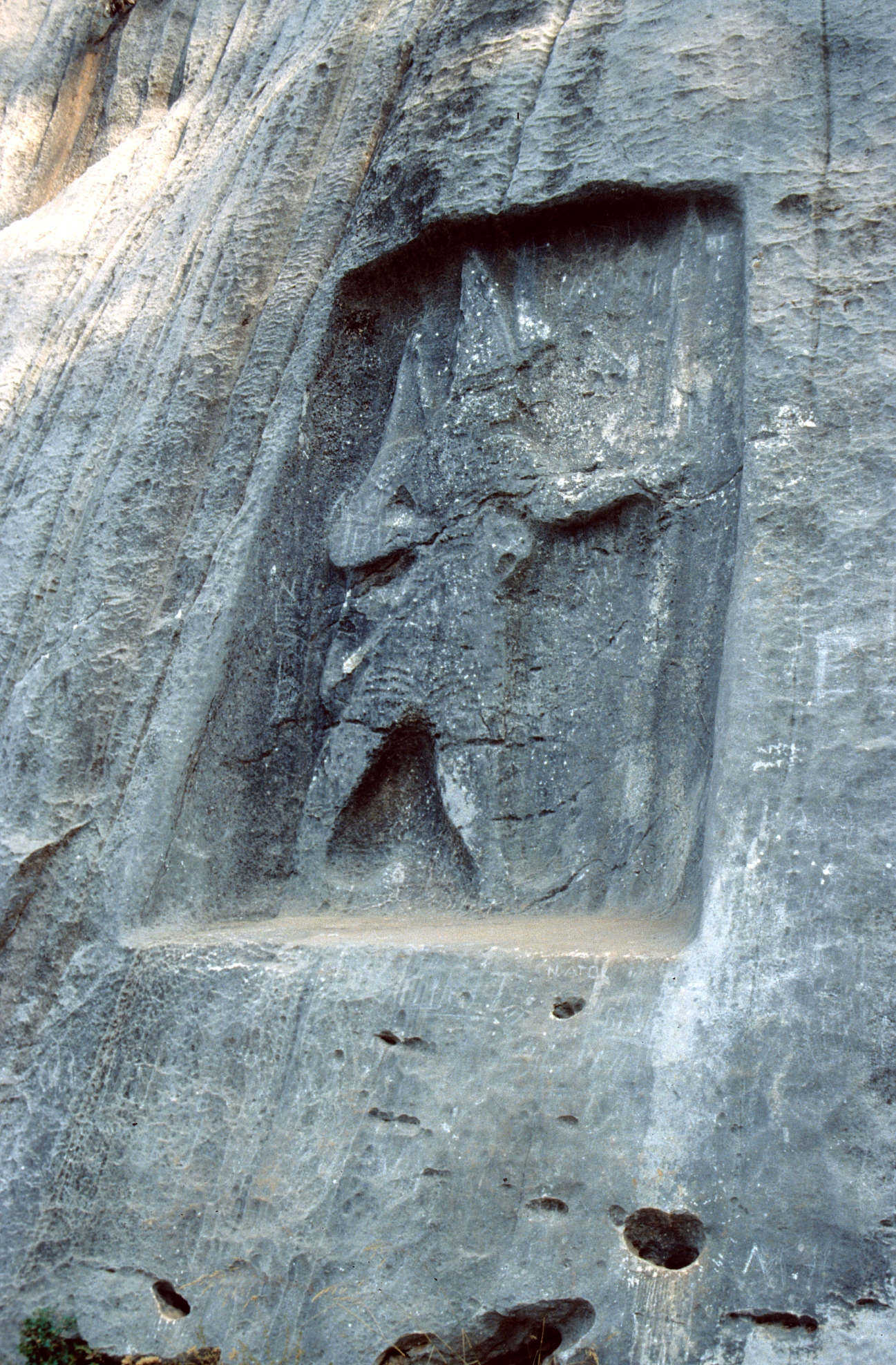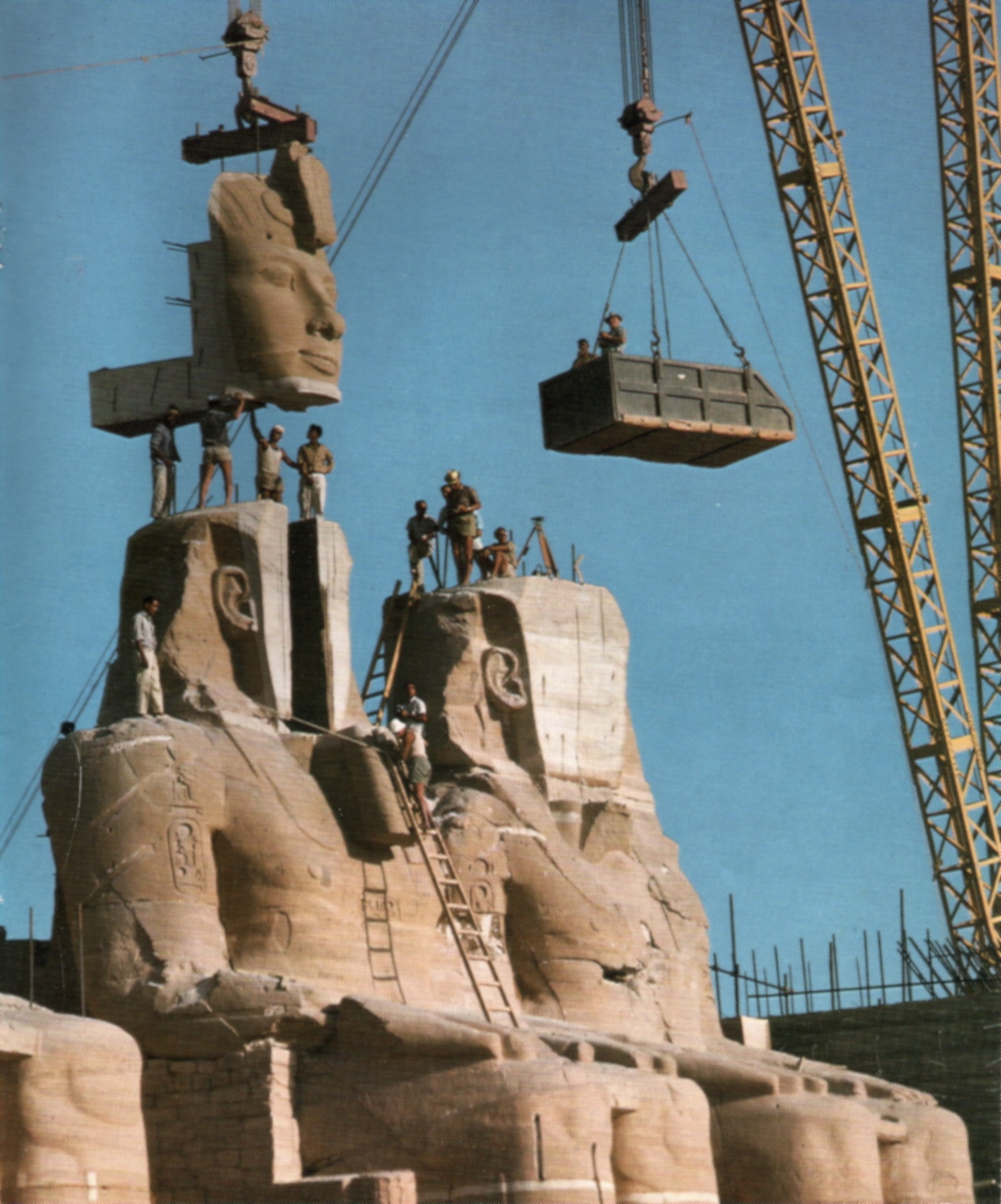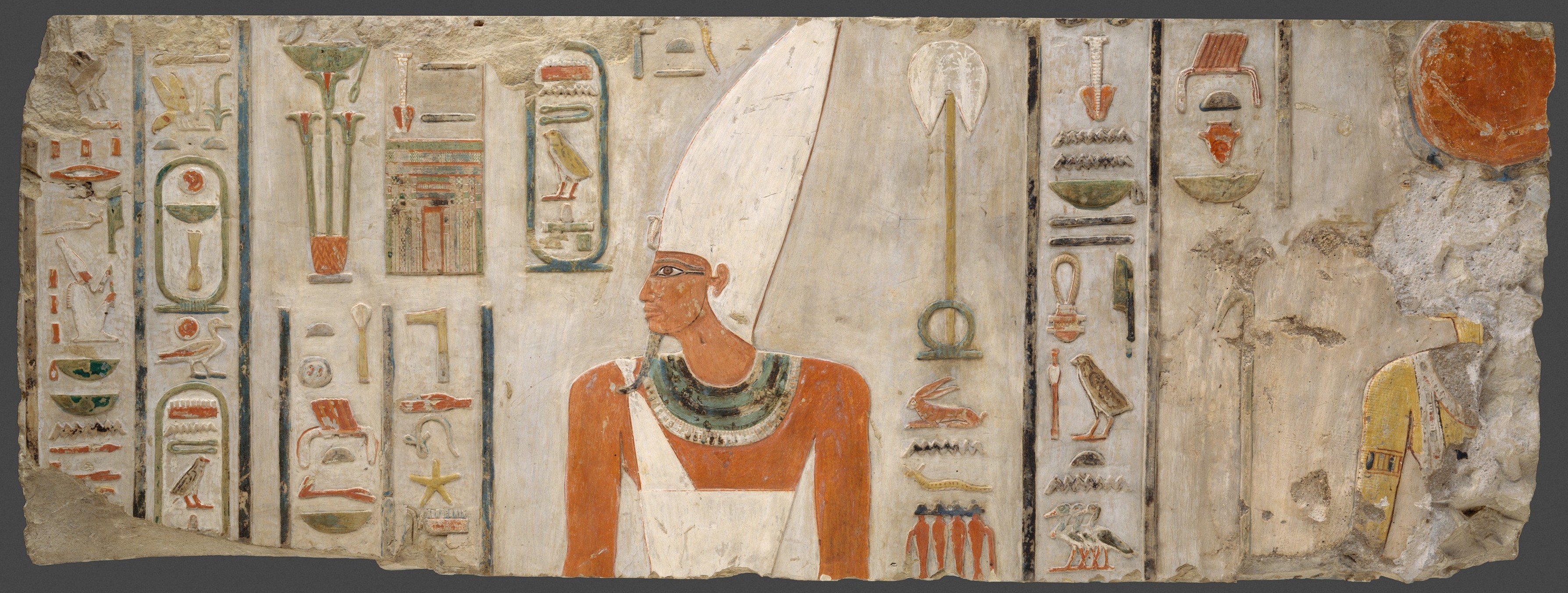|
Rock Relief
A rock relief or rock-cut relief is a relief, relief sculpture carved on solid or "living rock" such as a cliff, rather than a detached piece of stone. They are a category of rock art, and sometimes found as part of, or in conjunction with, rock-cut architecture. However, they tend to be omitted in most works on rock art, which concentrate on engravings and paintings by prehistoric peoples. A few such works exploit the natural contours of the rock and use them to define an image, but they do not amount to man-made reliefs. Rock reliefs have been made in many cultures throughout human history, and were especially important in the art of the ancient Near East. Rock reliefs are generally fairly large, as they need to be in order to have an impact in the open air. Most of those discussed here have figures that are over life-size, and in many the figures are multiples of life-size. Stylistically they normally relate to other types of sculpture from the culture and period ... [...More Info...] [...Related Items...] OR: [Wikipedia] [Google] [Baidu] |
Polonnaruwa
Poḷonnaruwa, (; ) also referred as Pulathisipura and Vijayarajapura in History of Sri Lanka, ancient times, is the main town of Polonnaruwa District in North Central Province, Sri Lanka. The modern town of Polonnaruwa is also known as New Town, and the other part of Polonnaruwa remains as the royal ancient city of the Kingdom of Polonnaruwa. The second-oldest of all Sri Lanka's kingdoms, Polonnaruwa was first established as a military post by the Sinhalese kingdom. It was renamed Jananathamangalam by the Chola dynasty after their successful invasion of the country's then capital, Anuradhapura, in the 10th century. The ''Ancient City of Polonnaruwa'' has been declared a World Heritage Site. Modern Polonnaruwa is undergoing a major development project known as the "Awakening of Polonnaruwa," championed by former President Maithripala Sirisena. It envisions the development of all sectors in Polonnaruwa including roads, Electric power transmission, electricity, agriculture, educati ... [...More Info...] [...Related Items...] OR: [Wikipedia] [Google] [Baidu] |
Neo-Babylonian
The Neo-Babylonian Empire or Second Babylonian Empire, historically known as the Chaldean Empire, was the last polity ruled by monarchs native to ancient Mesopotamia. Beginning with the coronation of Nabopolassar as the King of Babylon in 626 BC and being firmly established through the fall of the Assyrian Empire in 612 BC, the Neo-Babylonian Empire was conquered by the Achaemenid Persian Empire in 539 BC, marking the collapse of the Chaldean dynasty less than a century after its founding. The defeat of the Assyrian Empire and subsequent return of power to Babylon marked the first time that the city, and southern Mesopotamia in general, had risen to dominate the ancient Near East since the collapse of the Old Babylonian Empire (under Hammurabi) nearly a thousand years earlier. The period of Neo-Babylonian rule thus saw unprecedented economic and population growth throughout Babylonia, as well as a renaissance of culture and artwork as Neo-Babylonian kings conducted massive buil ... [...More Info...] [...Related Items...] OR: [Wikipedia] [Google] [Baidu] |
Sesostris
Sesostris () is the name of a king of ancient Egypt who, according to Herodotus, led a military expedition into parts of Europe. Tales of Sesostris are probably based on the life of Senusret I, Senusret III and perhaps other Pharaohs such as Shoshenq I and Ramesses II. Sesostris' name is also given as Sesoösis or Sesonchosis in other sources. Account of Herodotus In Herodotus' Histories (Herodotus), ''Histories'' there appears a story told by Egyptian priests about a Pharaoh Sesostris, who once led an army northward overland to Asia Minor, then fought his way westward until he crossed into Europe, where he defeated the Scythians and Thracians (possibly in modern Romania and Bulgaria). Sesostris then returned home, leaving colonists behind at the river Phasis (river), Phasis in Colchis. Herodotus cautioned the reader that much of this story came second hand via Egyptian priests, but also noted that the Colchians were commonly believed to be Egyptian colonists. Herodotus also ... [...More Info...] [...Related Items...] OR: [Wikipedia] [Google] [Baidu] |
Pharaoh
Pharaoh (, ; Egyptian language, Egyptian: ''wikt:pr ꜥꜣ, pr ꜥꜣ''; Meroitic language, Meroitic: 𐦲𐦤𐦧, ; Biblical Hebrew: ''Parʿō'') was the title of the monarch of ancient Egypt from the First Dynasty of Egypt, First Dynasty () until the Roman Egypt, annexation of Egypt by the Roman Republic in 30 BCE. However, the equivalent Egyptian language, Egyptian word for "king" was the term used most frequently by the ancient Egyptians for their monarchs, regardless of gender, through the middle of the Eighteenth Dynasty during the New Kingdom of Egypt, New Kingdom. The earliest confirmed instances of "pharaoh" used contemporaneously for a ruler were a letter to Akhenaten (reigned –1336 BCE) or an inscription possibly referring to Thutmose III (–1425 BCE). In the early dynasties, ancient Egyptian kings had as many as ancient Egyptian royal titulary, three titles: the Horus name, Horus, the prenomen (Ancient Egypt), Sedge and Bee (wikt:nswt-bjtj, ''nswt-bjtj''), and ... [...More Info...] [...Related Items...] OR: [Wikipedia] [Google] [Baidu] |
Herodotus
Herodotus (; BC) was a Greek historian and geographer from the Greek city of Halicarnassus (now Bodrum, Turkey), under Persian control in the 5th century BC, and a later citizen of Thurii in modern Calabria, Italy. He wrote the '' Histories'', a detailed account of the Greco-Persian Wars, among other subjects such as the rise of the Achaemenid dynasty of Cyrus. He has been described as " The Father of History", a title conferred on him by the ancient Roman orator Cicero, and the " Father of Lies" by others. The ''Histories'' primarily cover the lives of prominent kings and famous battles such as Marathon, Thermopylae, Artemisium, Salamis, Plataea, and Mycale. His work deviates from the main topics to provide a cultural, ethnographical, geographical, and historiographical background that forms an essential part of the narrative and provides readers with a wellspring of additional information. Herodotus was criticized in his times for his inclusion of "legends an ... [...More Info...] [...Related Items...] OR: [Wikipedia] [Google] [Baidu] |
Karabel Relief
The Hittites, Hittite / Luwian Karabel relief is a rock relief in the pass of the same name, between Torbalı and Kemalpaşa, about 20 km from İzmir in Turkey. Rock reliefs are a prominent aspect of Hittite art. Description The monument originally consisted of four parts: two ruler figures carved into the cliff (Karabel A and B) and two inscriptions on boulders (Karabel C1 and C2). During the construction of a road through the pass between 1977 and 1982, all the reliefs except for Karabel A were destroyed. Karabel A shows a warrior marching to the right with a bow in his right hand and a spear in his left. There are Luwian hieroglyphs inscribed above his left arm. The relief is 1.5 m wide and 2.5 m high The Karabel relief was damaged by unknown persons, presumed to be treasure hunters, in early 2019. Research history Herodotus interpreted the figure as the Egyptian Pharaoh Sesostris. The relief was visited by the French traveller Charles Texier in 1839 – he publi ... [...More Info...] [...Related Items...] OR: [Wikipedia] [Google] [Baidu] |
Hittite Art
Hittite art was produced by the Hittite civilization in ancient Anatolia, in modern-day Turkey, and also stretching into Syria during the second millennium BCE from the nineteenth century up until the twelfth century BCE. This period falls under the Anatolian Bronze Age. It is characterized by a long tradition of canonized images and motifs rearranged, while still being recognizable, by artists to convey meaning to a largely illiterate population. “Owing to the limited vocabulary of figural types nd motifs invention for the Hittite artist usually was a matter of combining and manipulating the units to form more complex compositions"Many of these recurring images revolve around the depiction of Hittite deities and ritual practices. There is also a prevalence of hunting scenes in Hittite relief and representational animal forms. Much of the art comes from settlements like Alaca Höyük, or the Hittite capital of Hattusa near modern-day Boğazkale. Scholars have difficulty dating ... [...More Info...] [...Related Items...] OR: [Wikipedia] [Google] [Baidu] |
Lebanon
Lebanon, officially the Republic of Lebanon, is a country in the Levant region of West Asia. Situated at the crossroads of the Mediterranean Basin and the Arabian Peninsula, it is bordered by Syria to the north and east, Israel to the south, and the Mediterranean Sea to the west; Cyprus lies a short distance from the coastline. Lebanon has a population of more than five million and an area of . Beirut is the country's capital and largest city. Human habitation in Lebanon dates to 5000 BC. From 3200 to 539 BC, it was part of Phoenicia, a maritime civilization that spanned the Mediterranean Basin. In 64 BC, the region became part of the Roman Empire and the subsequent Byzantine Empire. After the seventh century, it Muslim conquest of the Levant, came under the rule of different Islamic caliphates, including the Rashidun Caliphate, Rashidun, Umayyad Caliphate, Umayyad and Abbasid Caliphate, Abbasid. The 11th century saw the establishment of Christian Crusader states, which fell ... [...More Info...] [...Related Items...] OR: [Wikipedia] [Google] [Baidu] |
Rameses II
Ramesses II (sometimes written Ramses or Rameses) (; , , ; ), commonly known as Ramesses the Great, was an Egyptian pharaoh. He was the third ruler of the Nineteenth Dynasty. Along with Thutmose III of the Eighteenth Dynasty, he is often regarded as the greatest, most celebrated, and most powerful pharaoh of the New Kingdom, which itself was the most powerful period of ancient Egypt. He is also widely considered one of ancient Egypt's most successful warrior pharaohs, conducting no fewer than 15 military campaigns, all resulting in victories, excluding the Battle of Kadesh, generally considered a stalemate. In ancient Greek sources, he is called Ozymandias, derived from the first part of his Egyptian-language regnal name: . Ramesses was also referred to as the "Great Ancestor" by successor pharaohs and the Egyptian people. For the early part of his reign, he focused on building cities, temples, and monuments. After establishing the city of Pi-Ramesses in the Nile Delta, h ... [...More Info...] [...Related Items...] OR: [Wikipedia] [Google] [Baidu] |
Commemorative Stelae Of Nahr El-Kalb
The commemorative stelae of Nahr el-Kalb are a group of over 20 inscriptions and rock reliefs carved into the limestone rocks around the estuary of the Nahr al-Kalb (Dog River) in Lebanon, just north of Beirut. The inscriptions include three Egyptian hieroglyphic stelae from pharaohs including Ramesses II, six cuneiform inscriptions from Neo-Assyrian and Neo-Babylonian kings including Esarhaddon and Nebuchadnezzar II, Roman, Latin and Greek inscriptions, Arabic inscriptions from the Egyptian Mamluk sultan Barquq and the Druze prince Fakhr-al-Din II, a memorial to Napoleon III's 1860 intervention in Lebanon and a dedication to the 1943 independence of Lebanon from France. As such, the site has been said to summarise all of Lebanon's history in one place. The earliest European to identify the site was the 17th-century traveller Henry Maundrell in 1697, and was the first editor of the inscriptions in 1922. In 2005, the stelae at the river were listed in the UNESCO Memory of th ... [...More Info...] [...Related Items...] OR: [Wikipedia] [Google] [Baidu] |
Abu Simbel Temples
Abu Simbel is a historic site comprising two massive rock-cut temples in the village of Abu Simbel (), Aswan Governorate, Upper Egypt, near the border with Sudan. It is located on the western bank of Lake Nasser, about southwest of Aswan (about by road). The twin temples were originally carved out of the mountainside in the 13th century BC, during the 19th Dynasty reign of the Pharaoh Ramesses II. Their huge external rock relief figures of Ramesses II have become iconic. His wife, Nefertari, and children can be seen in smaller figures by his feet. Sculptures inside the Great Temple commemorate Ramesses II's heroic leadership at the Battle of Kadesh. The complex was relocated in its entirety in 1968 to higher ground to avoid it being submerged by Lake Nasser, the Aswan Dam reservoir. As part of International Campaign to Save the Monuments of Nubia, an artificial hill was made from a domed structure to house the Abu Simbel Temples, under the supervision of a Polish ... [...More Info...] [...Related Items...] OR: [Wikipedia] [Google] [Baidu] |
Middle Kingdom Of Egypt
The Middle Kingdom of Egypt (also known as The Period of Reunification) is the period in the history of ancient Egypt following a period of political division known as the First Intermediate Period of Egypt, First Intermediate Period. The Middle Kingdom lasted from approximately 2040 to 1782 BC, stretching from the reunification of Egypt under the reign of Mentuhotep II in the Eleventh Dynasty of Egypt, Eleventh Dynasty to the end of the Twelfth Dynasty of Egypt, Twelfth Dynasty. The kings of the Eleventh Dynasty ruled from Thebes, Egypt, Thebes and the kings of the Twelfth Dynasty ruled from Lisht, el-Lisht. The Periodization of ancient Egypt, concept of the Middle Kingdom as one of three golden ages was coined in 1845 by German Egyptologist Christian Charles Josias von Bunsen, Baron von Bunsen, and its definition evolved significantly throughout the 19th and 20th centuries. Some scholars also include the Thirteenth Dynasty of Egypt wholly into this period, in which case the Mi ... [...More Info...] [...Related Items...] OR: [Wikipedia] [Google] [Baidu] |






